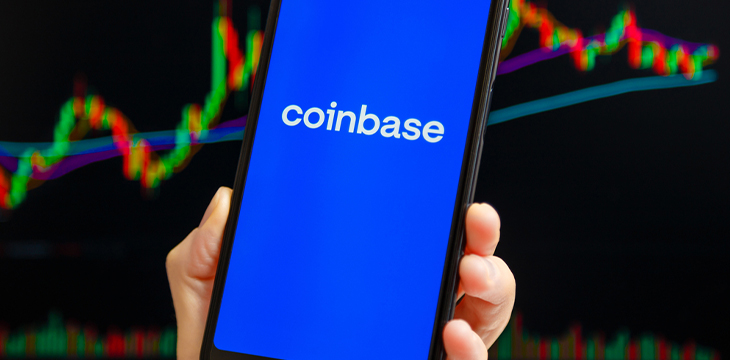|
Getting your Trinity Audio player ready...
|
The Coinbase (NASDAQ: COIN) digital asset exchange saw its transaction revenue and profit plunge in the second quarter, as both retail and institutional traders appear to have found better ways to occupy their time.
Figures released Thursday show Coinbase generated net revenue of $1.38 billion in the three months ending June 30, down 11% from $1.59 billion in the first quarter of 2024. Throw in nearly $70 million in ‘corporate interest and other income’ and total revenue was $1.45 billion, down from $1.64 billion in Q1.
Net income was $36 million, a fraction of the $1.18 billion Coinbase claimed in Q1. The Q1 figure was artificially inflated by $737 million, thanks to a new Financial Accounting Standards Board policy that allowed companies to report changes in the ‘fair value’ of their digital assets. But this wind blows both ways, and Q2 saw “$319 million in pre-tax crypto asset losses on our crypto investment portfolio.”
Overall trading volume tumbled 28% to $226 billion, while transaction revenue fell 27% to $781 million. Retail transaction revenue fell 29% to $665 million, while volume fell much harder (34%) than the overall figure. Institutional volume was off 26% to $189 billion, while revenue slipped a similar percentage to $63.6 million.
The retail trading slide is all the more noticeable given that Coinbase’s number of monthly transacting users (MTU) rose by around 200,000 to 8.2 million. A caveat that Coinbase includes ‘passive’ users in its MTU figures, including those who simply earn a staking reward, and the definition of transactions includes people hammering the ‘withdraw’ button.
As for what traders were trading, both BTC and ETH‘s share of volume inched up two points to 35% and 15%, respectively. Tether‘s controversial USDT stablecoin slipped one point to 10% and ‘other crypto assets’ aka utility-free shitcoins slipped three points to 40%.
The ‘other assets’ share of revenue fell harder, losing 13 points to 42%, but still eclipsed BTC (31%) and ETH (17%). The shitcoin slide is in part due to Solana‘s SOL token making its first-ever solo appearance on the revenue tally at 10%.
Curiously, no trading volume figures were supplied for the Bahamas-based derivatives-focused Coinbase International exchange, which launched in spring 2023. On Thursday’s analyst call, CEO Brian Armstrong said only that “volume has been really good today, actually,” which suggests volume sucked on Wednesday, but whatever. The company did say its transaction expenses would continue to rise as it worked to “create liquidity” at its international site.
To the moon Base
‘Other transaction revenue,’ which includes Base, the Ethereum-based ‘layer 2’ memecoin paradise, fell a modest 6.4% to $52.5 million. Coinbase serves as the only sequencer (transaction processor) on Base, and the company’s bid to build Base’s following saw it “significantly” reduce Base’s transaction fees in Q2. The result was a 300% growth in Base transaction volume.
It’s worth remembering that Coinbase has pledged to welcome other sequencers to Base “over time,” but there’s still no timetable for this. Given that Base is a proprietary network and appears integral to the company’s growth strategy, it will be interesting to see how long Coinbase can keep up the charade that the network will ever be anything other than a company store.
‘Subscription and services’ revenue fared far better in Q2, rising 17.2% to $599 million. The surge was led by stablecoin revenue rising nearly 22% to $240.4 million. Coinbase is a partner in the USDC stablecoin with its issuer Circle and the Q2 figure is by far the highest in this category to date.
Blockchain rewards aka staking rose 22.6% to $185 million, while additional gains came from interest/finance fees ($69.4 million, +4%), custodial fees—including from BTC/ETH exchange traded funds (ETFs) ($34.5 million, +6.8%) and ‘other’ ($69.6 million, +9.2%).
The rising cost of making it rain
Operating expenses also increased, rising 26% to $1.1 billion despite a significant fall in transaction expenses. The biggest driver of this increase was a two-thirds increase in sales and marketing costs ($165.3 million), which the company blamed on “higher USDC rewards.”
To be clear, ‘rewards’ is how Coinbase camouflages its staking ‘yield.’ It’s a half-baked effort to avoid additional Securities and Exchange Commission (SEC) blowback by pretending staked tokens aren’t unregistered securities.
General and administrative costs were up 11.5% to $320 million, “primarily driven by policy spend in support of driving regulatory clarity.” Coinbase has donated over $50 million to various crypto-focused political action committees (PACs), including Defend American Jobs (pro-Republican), Protect Progress (pro-Democrat) and Fairshake (pro-anyone who loves crypto).
The ‘other’ expenses category shot up from $2.4 million in Q1 to $34.4 million, which Coinbase said was “driven by an increase in costs due to platform-related incidents.”
Total stock-based compensation to Coinbase’s senior execs came in at $218 million, a lower figure than the $237 million the company originally projected for Q2. (Expect something resembling a Brooks Brothers riot if this type of shortchanging continues.) Coinbase expects to dole out $230 million to its execs in Q3.
Some of those well-compensated execs are cashing out as fast as they can. Armstrong sold $216 million of his shares since November, while co-founder Fred Ehrsam III sold $270 million over the same period. Armstrong previously announced he’d be selling some shares to fund “scientific research,” which we suspect is like those Japanese ‘scientific whaling’ fleets who somehow still haven’t cracked the mystery of what happens when you shoot explosive harpoons into large mammals.
Looking ahead to Q3, Coinbase said it generated $210 million in total transaction revenue in July, putting it on pace for an even worse transaction figure than in Q2. Q3’s subscription and service revenue is expected in the range of $530-$600 million. And expenses are tipped to rise as the company tries to encourage its retail customers to actually buy or trade something.
Gotta spend money to make money
Speaking on the analyst call, Armstrong expressed optimism regarding the potential for ‘regulatory clarity’ to emerge from the U.S. Congress. Armstrong claimed to see “real energy in the Senate,” despite Sen. Debbie Stabenow (D-MI) declaring this week that her draft bill that would hand most crypto oversight to the Commodity Futures Trading Commission (CFTC) will require “a Republican senator to step up” or it’s not moving forward.
Despite the rabidly pro-Trump stance by most high-profile crypto execs (and some even more rabidly anti-Democrat types), Armstrong claimed “crypto is really nonpartisan.” Armstrong also claimed Fairshake and the other PACs were “helping to elect pro-crypto candidates” regardless of party affiliation.
That ‘helping to elect’ claim took a hit this week as Blake Masters went down to defeat (again) in his bid to secure the GOP nomination to represent Arizona’s 8th district in the U.S. House of Representatives. Defend American Jobs donated nearly $600,000 to Masters’ primary campaign, but he lost to rival Abe Hamadeh.
Coinbase is tied with XRP issuer Ripple Labs and the individuals behind the tech-focused Andreessen Horowitz private equity group as the largest contributors to Defend American Jobs. The trio has splashed out far more to the Fairshake PAC, which is among the largest PACs in terms of dollars raised in the current election cycle.
According to Molly White’s Citation Needed blog, $25 million of Coinbase’s roughly $46.5 million in total Fairshake contributions may have violated federal campaign finance law, which prohibits federal government contractors from engaging in this sort of blatant influence buying.
In July, Coinbase inked a deal to help the U.S. Marshalls Service (USMS) in “managing and disposing of large quantities of popular cryptocurrency assets” that the feds have seized from various scofflaws over the years. The tender opened in March, while Coinbase’s $25 million Fairshake contribution was made on May 30, meaning it fell within the period in which companies seeking to do business with the feds are prohibited from making contributions to political entities.
A day later, Coinbase’s chief legal officer, Paul Grewal, called White’s suggestion that Coinbase violated the rules “misinformation. Coinbase is not a federal contractor under the plain language” of campaign finance law. Grewal also claimed that “USMS isn’t paying us with appropriated funds—something it made clear in the public [request for proposal].”
White can be forgiven for assuming the worst, given crypto’s ‘ready, fire, aim’ history. Earlier this year, the Winklevoss twins of Gemini fame and Kraken co-founder Jesse Powell made a big splash of donating $1 million apiece to Donald Trump’s presidential campaign. None of them understood (nor bothered to inquire) that the maximum individual contribution is $844,600, forcing the campaign to refund the difference.
Pushing the limits
Coinbase’s U.K. offshoot was fined £3.5 million ($3.7 million) last week for “significant weaknesses” in its anti-money laundering protocols. These deficiencies led to the company “repeatedly breaching a requirement that prevented the firm from offering services to high-risk customers.”
Despite this and other regulatory brushbacks, Coinbase raised eyebrows when it announced that Coinbase Wallet users could now transfer USDT from the Tron blockchain and the USDT would automatically and without charge convert to USDC on Base. For the time being, this option is available in “parts of Latin America, Africa and Asia-Pacific, including Argentina, Brazil, Ethiopia, South Africa, India, and Pakistan.”
On Thursday’s call, Armstrong claimed Base was handling over $20 billion in USDC transactions per week and this USDT conversion appears intended to goose that figure even higher. But you have to wonder if this will be worth the potential headache.
USDC issuer Circle had only recently announced it was “discontinuing” USDC’s presence on Justin Sun’s scandal-plagued Tron after it apparently failed to satisfy Circle’s ‘risk management framework.’ Precisely how Coinbase intends to observe adequate ‘know your customer’ (KYC) procedures when accepting all this USDT from Tron’s lawless environs remains a mystery.
USDC was previously suspected of unwittingly serving as exit liquidity for USDT holders who—due to Tether’s inability to sustain U.S. banking relationships and its unwillingness to redeem USDT for any but the largest holders—lacked the ability to convert USDT to cash. Now Coinbase/Circle are going to knowingly perform this service?
It could simply be a market share-grab, based on Circle/Coinbase’s expectation that U.S. law enforcement agencies and legislators are finally preparing to lower the boom on Tether. Or maybe Coinbase is just that desperate to maintain the ‘number go up’ trajectory of its one clear growth area.
Watch: Teranode is the future of the Bitcoin network

 01-05-2026
01-05-2026 




